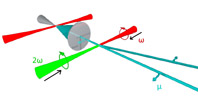Department of Physics and Astronomy: Publications and Other Research
ORCID IDs
Date of this Version
2015
Document Type
Article
Citation
Eur. J. Phys. 36 (2015) 065048 (20pp)
Abstract
Basic explanations of the double slit diffraction phenomenon include a description of waves that emanate from two slits and interfere. The locations of the interference minima and maxima are determined by the phase difference of the waves. An optical wave, which has a wavelength λ and propagates a distance L, accumulates a phase of 2 πL/λ. A matter wave, also having wavelength l that propagates the same distance L, accumulates a phase of πL/ λ, which is a factor of two different from the optical case. Nevertheless, in most situations, the phase difference, Δ Φ, for interfering matter waves that propagate distances that differ by Δ L, is approximately 2π Δ L/ λ, which is the same value computed in the optical case. The difference between the matter and optical case hinders conceptual explanations of diffraction from two slits based on the matter–optics analogy. In the following article we provide a path integral description for matter waves with a focus on conceptual explanation. A thought experiment is provided to illustrate the validity range of the approximation Δ Φ ≈ 2π Δ L/ λ.


Comments
© 2015 IOP Publishing Ltd. Used by permission.